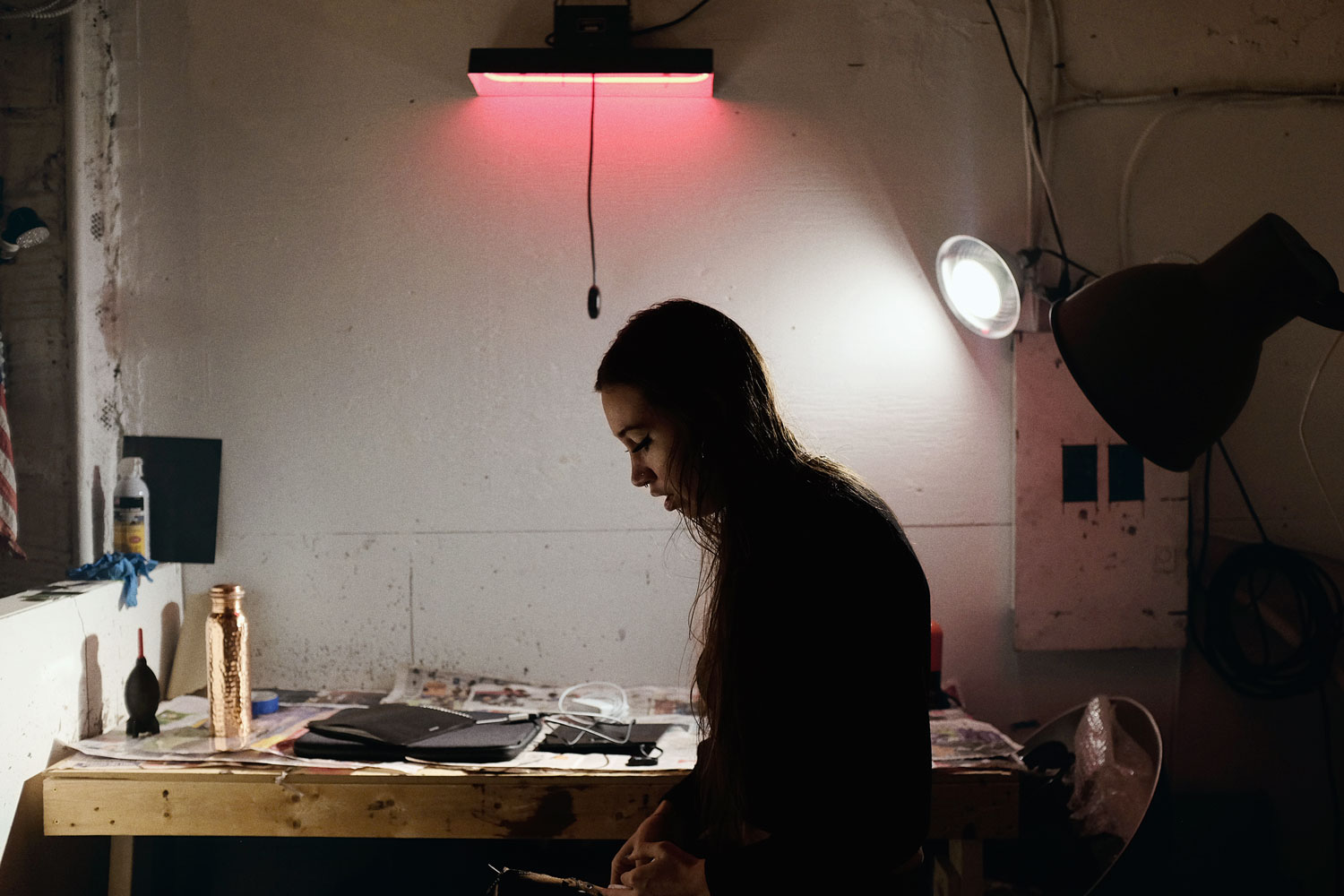As a primarily self-taught interdisciplinary artist of Indigenous/European descent (Nahuat, Mayan/Spanish, Irish) Alexa Black is “a bridge, a person in between”. On a healing journey reconnecting with her ancestors she is currently creating a tarot deck made of tintype photographs which refute the colonial gaze and invite mysticism, collaboration and connection instead.
Mitztemoa noyollo.
Alexa, I appreciate you talking to me. Let us start at the beginning, how did you get into art?
Art is a part of my first memories. My mom has pictures of me as a two-year-old painting the walls with lipstick. As cute as that is, it was never really supported. I have videos from when I was five, having an art show in the kitchen and I am explaining how everything was going to be okay which is kind of funny because I remember everything being really tense in my life when growing up. I remember always being ready to go, because my mum and my biological father had a very toxic relationship. He wasn’t in my life right from the beginning for good reasons. I’ll leave it at that.
All I wanted as a kid was to be seen and heard for who I really was, which was somebody trying to connect to that divine source, where one felt safe. I think we all have the potential to be creators. For the most part, I believe art is something that you need to have a level of stillness for, where you slow the fuck down and you move into a certain place in your softness.
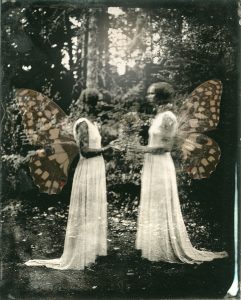
I can sense that you have a lot of understanding for your family for not enabling that space.
My grandmother and mother, both Nahuat Pipil and partly Mayan women, had fled from the civil war in El Salvador and came over to Canada in the 80s. Poverty was a big fear for my family. They were afraid of art leading me down that path. Mixed or indigenous people migrating North as refugees were considered immigrants, despite pre-colonial migrations and territories. Being indigenous was associated with poor treatment, so in order to survive, they never talked about their indigeneity. Culture was truly left behind in order to assimilate for survival… So art, being such a strong component of culture was definitely not a priority for my family.
What did you start out doing instead of art?
My paternal grandfather offered to pay for a practical degree in nursing so that I could be independent. Because my mother always dreamed of helping people as a nurse, I took the offer. It was painful for me. It’s hard for me to have a regimented life with a schedule. In order to cope with going against my creative self, I used a lot of drugs. During my degree process, it got quite severe and I became dependent on stimulants. They got me through school, but the art went away. I was so detached from my spirit that I couldn’t create.
How did you reconnect with it?
I got super sick. I don’t want to put this kind of pressure on my illness, but maybe it became a trigger to remind me of my purpose. Through it, I really reconnected to my art practice again, and I started learning about tintype photography at 26.
Why this ancient practice of all things?
There was a time in my early 20s where I was very anti-technology, and I was really angry at the system and what was going on in the world. I needed something that was like magick or that had the essence of conjuring and scrying. Something that would bring me back into my body and connect me to the land. When I found tintype photography I knew instantly. You don’t need anything except the elements and the chemistry, and you can shoot on a rusty can if you need to.
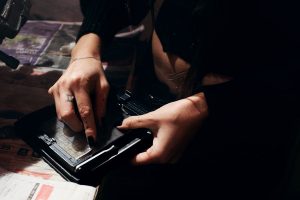
You are working on a special project right now the creation of your own set of tarot cards. You dreamed them up?
Yeah, I dreamed about it for sure. My adopted father is of mixed Cree/European descent. He and my mother were on a big healing journey and introduced me to their indigenous teachings and spirituality at a young age. It felt like it was old inside of me, as if it had been with me for lifetimes. My parents ended up going to AA meetings a lot, where they were highly influenced by some white christian folks and ended up converting. But I stayed with my traditional teachings and was adopted into another family out in Merritt. Ko’waintco Michele is my adopted spiritual mother. She oversaw me for a few years of vision fasting.
Is this a practice you can, or want, to share your experience with?
I ended up fasting every spring for a few years starting around age 23… I would go for as long as two to four days without food or water, or however long it took me to have a vision basically. It was during those times when you would set your intention for the rest of the year. Without water you’re really in a totally different universe. At first you feel like you’re burning from the inside out, it hurts to pee, and you feel really fucked up and a little scared, and then things become crystal clear. The whole point is that your body becomes weak and your spirit becomes strong.
Through my visions, I gravitated towards this medium of divinity and there was a tarot deck in my head that I was going to create, because I really couldn’t stand the colonial construct of a traditional deck, and I wanted to create space for intersectionality to account for human complexity. The other part was how passionate I felt about bringing magick down to earth for people. It’s so special that you can connect to this omnipotent, omniscient consciousness by using a tool.
That sounds like everything you needed was there already, you just needed to connect to it.
It’s there but it’s just so bogged down by these lower material vibrations that we have to constantly disconnect from. Art can move energy. I don’t really use words very much, as I’m not a writer. I think it’s because I don’t like my colonial languages, Spanish and English. It kills me that I don’t have access to my languages, I’ve only heard and understood them a couple times in dreams. I heard that someone who preserves their language preserves their spirit.
There is another important concept for you developed by Gloria Anzaldúa?
She is a queer, mestiza femme who coined the term “Nepantla”, in Nahuatl, which means to share cultural and spiritual knowledge from one group of people to the next. It’s about building tolerance for contradiction, and not rejecting any part of yourself, but instead, understanding it as a new consciousness. When I read her book “Borderlands/La Frontera: The New Mestiza” I just wept and held onto that for dear life. I get emotional talking about it.
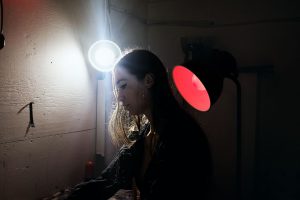
“Nepantleras are threshold people; they move within and among multiple, often conflicting, worlds.”
Being half white, and living in so called “Canada,” I feel as though my indigeneity is perpetually erased. Because of my mix, my mom’s traditional territory spans all the way from the Four Corners down to El Salvador. Unless you’re Nahuat, you don’t know that. People will call you Hispanic, or Latina, and for me that’s a defeat to my people to wear a colonial label. A lot of my work is moved by the anger I feel towards the erasure of my people. As a mixed race person, the world tells you you’re not indigenous enough, not white enough, it’s all enraging. My identity is not up for debate or colonial policing. I represent the in between but choose to give voice to what has been silenced. At the same time it is very important to me to acknowledge my privilege that comes from being hugely white passing.
The main thing for me was to hear from my whole family “You reclaiming your indigeneity and you introducing yourself as a primarily Nahuat woman allows us to heal. Just keep doing what you’re doing.”
Does all that play into your tarot?
The deck is about creating a home. The only place that feels like home is here doing this. I get asked “what’s your mix?” all the time. I can’t go back to my mum’s land because I wasn’t born there and it’s violent as fuck — so I don’t know if it’s home or not, colonialism has damaged it so much. My ambiguity is a pillar of my creativity. I’m always in a contradiction and eventually I learned that is okay and actually kind of special. It’s been uncomfortable and fucking lonely but when I get to this place where I create this work, it’s when I can connect and feel whole from the contradiction the most. Does that make sense?
Absolutely.
And each of my models is in between too. They are mixed raced or mixed genders or have multiple personalities, they are in between a liminal state of mind or physical health or in active addiction. This art project is not about objectifying or exploiting somebody’s lived experience whatsoever. It’s about me finding folks who want to heal, and want to find a place of belonging as well. There’s rarely a time when I don’t have a two-hour conversation with somebody before the shoot who doesn’t have a huge emotional breakdown and that’s beautiful. It becomes therapeutic, and a labour of love, and that is really why I am doing this. I’m creating space for them to move through that in whatever way they choose and we are translating it into an ethereal piece of magick.
How do you turn that conversation into a visual?
In most cases, I show you a couple of images that I’ve made previously and explain them. I might ask which one you resonate with and if there is anything that you would like to add to the archetype. I don’t know how it happens, but so far, every time it ends up being in alignment with what the person is actually going through. Just as if someone was doing a tarot reading for you.
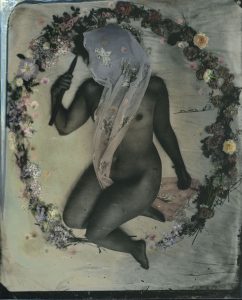
Photography also was, and remains, a colonial tool. If we think of countless so-called anthropological studies or nameless portraits of First Nations people. I love that you aim to turn this often objectifying and dehumanizing process on its head, and into a conversation. You give your subjects back their agency in a healing and empowering process. I wondered, is it also about reclaiming and finding new ways to create art, which lead away from the colonial and patriarchal gaze and acknowledge collaboration instead of feeding into a myth of ‘genius and object’?
That’s a hundred percent it. That person sitting in front of the camera is a collaborator. I couldn’t make any of this without their lived experience and their unique essence. Photography is an uncomfortable colonial art form and I’ve addressed that with almost all of my models. They are compensated for their time financially; they are always asked for their comfort level and consent and can withdraw it at any given point. They have total freedom as opposed to being captured.
I want to make them feel beautiful. I want to make them feel like everything they’ve gone through, and all of the discomfort in their worlds, all their sensitivities, can just be there in one moment. I hope they can come into a space of self love.
Could explain your interpretation of the card Judgement to me?
It is the birth of a new consciousness — somebody is definitely resurrected in the image. This arcanum really speaks to one of the hardest experiences I’ve ever been through. It reminds me of the madness I went through when I was getting clean. I moved, quit my job and lost all my friends with a relationship of five years. Everything I surrounded myself with and identified with was lost overnight. I ended up going back to the Four Corners and I stayed in the desert for months. I sat down with the plants and with what felt like lifetimes of trauma. I remember this constant feeling of a resurrection. I didn’t know who I was anymore because I had wrapped my identity around another person and my addiction. I was 27 and it was the rudest awakening. But when you realize you’re still surviving, and you realize your power and resilience, you open yourself up to something greater. You have created space for this divinity to come into you. Where your greatest fear is, your power also lies. Most of us are so scared of our true selves. I didn’t know I could trust Alexa to create, and to go live on her true path. I’ve always had a fear of failing, as I associated it with abandonment. But the only true abandonment is for me to leave myself and to not let this spirit create.


